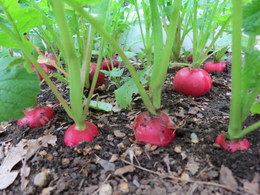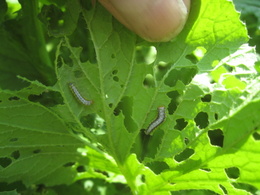Radish Growing Guide
Radish (Raphanus sativus) is an annual and is most often sliced up in a salad or thought of as a garnish, usually in the form of a rosette to decorate your food. In addition to the familiar round red ones there are varieties with longer carrot-like roots that may be red, red and white to all white roots.
Radishes are one of the cruciferous vegetables you should eat on a regular basis and is an important source of essential nutrients and fiber. A partial list of common cruciferous vegetables is: bok choy (Chinese cabbage), broccoli, Brussels sprouts, cabbage, cauliflower, collard greens, kale, kohlrabi and radish.
They are cool weather vegetables and are frost tolerant. The 2-major types are the spring variety and the winter variety. The spring variety grow very quickly and can be harvested in 22 to 28-days and have the nice round root that is so common. The winter variety will take 52 to 70-days to reach maturity and have larger roots much like carrots and can be stored like carrots.
Soil Preparation
Radishes should be planted in a nice loose well-drained garden soil and do best in a slightly acid soil with a pH range of 5.8 to 6.8. They should have 3 to 6-hours of full sun to light or dappled shade.
Planting Radish
Radishes do not transplant well and should be direct sown.
The spring variety of radish seeds can be direct sown 3 to 6-weeks before your last expected frost. Sow the seeds 1/2-inch deep 1-inch apart in rows about 6-inches apart, covering with fine cover of soil. Thin to about 2-inches apart. If they are too crowded the roots may not develop properly. Radishes do best during the cool weather in the spring and fall.
The winter variety grow more slowly taking about 52 to 70-days to mature. The time to sow the seeds is midsummer to late summer.
Radish seeds germinate very quickly, typically in 3 to 5-days and are ready to harvest in 3 to 5-weeks. Their quick growth makes them popular with young children who are impatient and like to see quick results.
For more detailed information visit the seed starting page.
Watering and Care
After the seeds germinate start adding a layer of mulch to help retain moisture and keep out competing weeds. During dry spells give some water each week. They are a cool weather crop that likes cool moist soil.
If needed you can feed with an organic fertilizer such as Espoma Garden-tone.
Spring Varieties
Burpee White, Champion, Cherry Belle, Cherry Queen Hybrid, Early Scarlet Globe, French Breakfast, French Dressing, Fuego, Icicle, Plum Purple, Snow Belle.
Easter Egg seed packets are a mix of radish sizes and colors including red, purple, lavender, pink, rose, scarlet and white. Since you will be growing a variety your harvest time will be extended and you will be able to sample the many different radish varieties.
Winter Varieties
China Rose, Chinese White, Round Black Spanish, Tama Hybrid. Some of the roots look much like carrots growing 4 to 6-inches long.
Sources: Seeds Now, Burpee, Johnny’s Selected Seeds
Harvesting Radish
Harvest on a regular basis while still young. If the radishes get too old they may crack and split and be tough and woody. Check on the development by brushing some soil away from the root. Young radishes have a mild flavor and older ones have a hotter flavor.
The greens are edible with a peppery taste that varies by variety. The greens can be added raw to a salad or sautéed.
Diseases
There are several diseases that affect the cruciferous vegetables. These occasionally affect the roots and leaves. Crop rotation and removal of diseased plants is the best way to control them. Increasing plant spacing in the future helps increase air circulation around the plants.
Pests
Most of the cruciferous vegetables are all affected by many of the same pests. Some of these are: aphids and several species of cabbageworms and caterpillars.
The easiest way to deal with aphids without using chemicals is to knock them off with a spray of water. Ladybug beetles will eat many aphids. Many gardeners will purchase them and release them in their garden to help control the aphids that are a problem with many plants.
Serious infestations can be controlled with an organic product such as insecticidal soap or neem oil. These are both organic controls that are very effective.
The cabbageworms and caterpillars cause damage by eating holes in the leaves. The adult moth lays small eggs on the underside of the leaves, which hatch out as larvae and do the damage. They multiply very rapidly, so inspect your plants often early in the morning, between the leaves and the underside for small caterpillars and egg masses.
Cabbageworms can be removed by hand picking them as you inspect your plants. Spraying your plants every 1 or 2-weeks with a special variety of BT (Bacillus thuringiensis var. kurstaki) will kill the cabbageworms. There are also several products that contain spinosad, a naturally occurring insecticide.
Duct tape helps to remove the caterpillars and eggs. Take a piece about 8 or 9-inches long and attach the ends together to form a loop with the sticky side out. Put one hand through the loop and with the other lift up a leaf looking for any caterpillars or eggs. If you find any caterpillars stick them to the tape and do the same for the eggs.
Cabbage root maggot larvae feed on the roots of the plants, which in the beginning causes wilting and plants to die later on. The best prevention is to toss the entire plant in the garbage after harvesting, including any soil that clings to the roots. The best way to reduce any future problems is to rotate your crops to a new location each year. Row covers are about the only way to control the cabbage root fly. Place the row covers over the plants in the spring right after putting them in the ground.
Tips and Warnings
To keep a continuous supply coming sow more seeds every 7 to 10-days. Harvest while still young before they get woody.
Mulch and water when needed.
Garden Spikes newsletters give you timely information once or twice a month. Subscribe Free to the Garden Times newsletter below.
Your email address will only be used to send you a newsletter and will never be sold. You can unsubscribe at any time.


